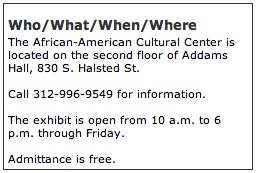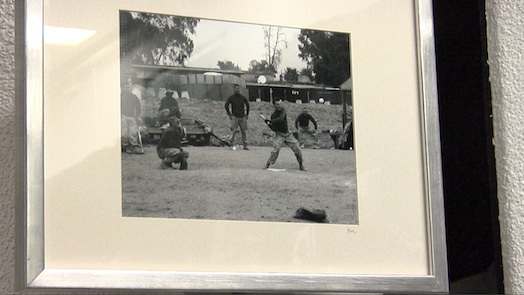
Tammy Thueringer/MEDILL
A picture on loan from the National Veterans Art Museum show Marines playing baseball in Ramadi.
“There is a saying and it goes back to WWI,” Adams said. “War is long stretches of absolute boredom, punctuated by moments of sheer terror. So when we were bored, we would find absolutely anything we could do to occupy our minds and if we had enough time and space, stuff like this would happen, baseball or any other game that reminded us of home.”
Almost everyone has heard of Tim O’Brien’s “The Things They Carried,” a book that chronicles what it was like to be a soldier in Vietnam.
Through Friday, an exhibit at the University of Illinois at Chicago updates O’Brien, calling the collection of helmets, backpacks, uniforms and pocket Bibles “The Things We Carried.”

Tammy Thueringer/MEDILL
Adams says the bigger of the two Bibles is ubiquitous to the military, but the small bible is special. “It belonged to a WWII Navy vet and it was carried with him throughout out the Pacific,” Adams said. Also pictured is a KA-BAR knife.
“It’s a standard issued Marine Corps knife,” Adams said. “It’s kind of synonymous with the Marine Corps, you say KA-BAR and every Marine’s got one. They love it.”
It’s a collection of items and photographs culled from UIC students who have served in Iraq and Afghanistan and it’s designed to give visitors a glimpse of what daily life was like for the men and women while they were deployed, fighting in past and present wars.
The student veteran who is curator of the temporary exhibit, Kenneth Adams, said, “‘The Things They Carried’ was a very influential book for me. It highlighted some of the things Vietnam era vets had carried with them and stories of the Vietnam War, and now that it’s our generation I figured we could kind of tell people what we carried.”
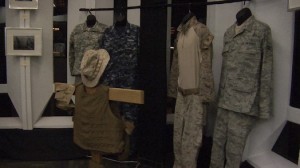
Tammy Thueringer/MEDILL
Four service uniforms show what members of the military wear. Army (far left), Navy (second to left), Marine Corps combat uniform (second to right) and Air Force (right).
“Up front is a battle cross with a flack jacket with a bullet proof vest, boonie cap and magazine pouches,” Adams said. “It’s there to show what some actually carried into combat that protected us from shrapnel and bullets.”
Members of UIC’s Student Veterans Association collected the items on display.
Adams, a pre-med biology major, said he hoped the exhibit, different from typical displays, will allow fellow students to connect with him and other student veterans.
“When you go to a museum, you see things but you can’t connect a person to an item because the person’s not there,” Adams said. “But it’s like Joe is a T.A., so he teaches kids in classes, so kids can come in and see his knife and say, ‘Oh, that’s Joe’s knife, he carried that in Iraq with him,’ or they see me in class or just walking around campus and they say, ‘Oh, that’s Kenneth Adams, that’s his helmet, he wore that in Afghanistan.’”
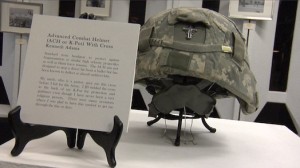
Tammy Thueringer/MEDILL
“This helmet is a standard issued ACH. They called it a K-Pot or a brain bucket,” Adams said. “My uncle gave me a cross before I left for the military, it was originally a necklace but I don’t like putting anything on my neck because of safety hazards, so I took it off and attached it to my helmet.”
The exhibit isn’t just aimed at traditional students. Adams calls one wall, which is lined with camouflage netting, “a work in progress.” He said ideally fellow veterans would see the collection and come together to share experiences with each other.
“We did this to connect the exhibit to other veterans and maybe have them make themselves part of the exhibit by putting a patch up there or a picture or something like that,” Adams said.
The exhibit, housed in UIC’s African-American Cultural Center, ends Friday. Members of UIC’s Student Veterans Association will be on hand during selected times to offer guided tours and interpretations of exhibit items as well as photographs that are on loan from the National Veterans Art Museum.
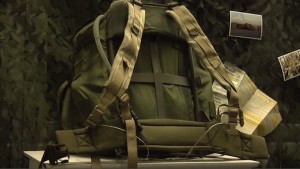
Tammy Thueringer/MEDILL
“It’s a standard issue ALICE Pack is what it’s usually called, or a LC-1 Pack,” Adams said. “The frame and design have been around forever. You can’t make something better that’s already good enough.”

